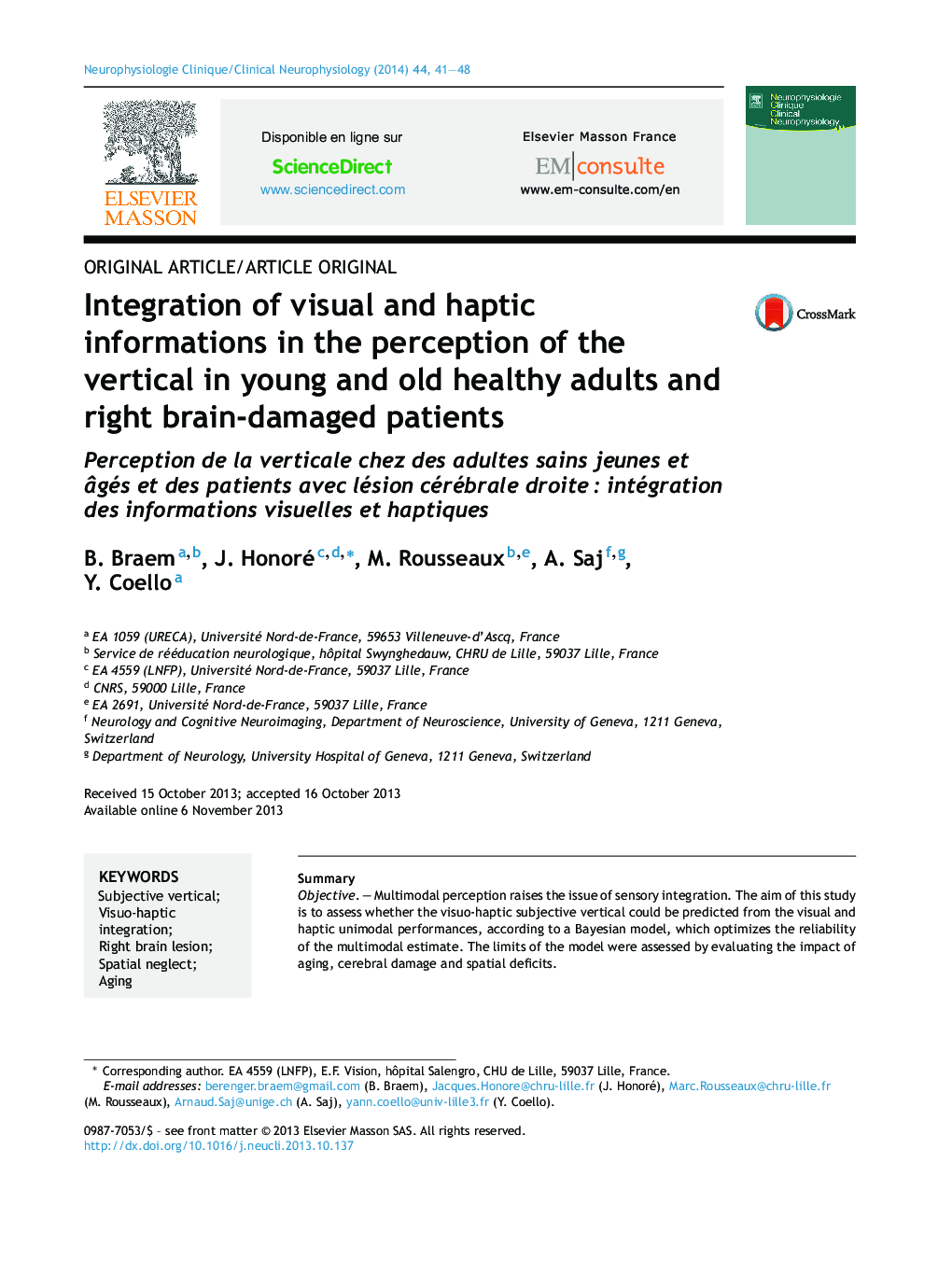| Article ID | Journal | Published Year | Pages | File Type |
|---|---|---|---|---|
| 3082329 | Neurophysiologie Clinique/Clinical Neurophysiology | 2014 | 8 Pages |
SummaryObjectiveMultimodal perception raises the issue of sensory integration. The aim of this study is to assess whether the visuo-haptic subjective vertical could be predicted from the visual and haptic unimodal performances, according to a Bayesian model, which optimizes the reliability of the multimodal estimate. The limits of the model were assessed by evaluating the impact of aging, cerebral damage and spatial deficits.MethodYoung and older healthy participants, as well as patients with a right hemisphere lesion, suffering from spatial neglect or not, had to align a rod with the gravitational vertical in the visual, haptic and visuo-haptic modalities.ResultsVisuo-haptic subjective vertical was correctly predicted by the model in healthy participants, as well as in patients in spite of different performances. An anticlockwise deviation of the subjective vertical was observed in the neglect group whatever the experimental conditions. By contrast, no deviation was observed in both non-neglect and healthy groups, for the visual and the visuo-haptic modalities. Nevertheless, the haptic subjective vertical was deviated, anticlockwise in the non-neglect patients and older healthy adults, and clockwise in the young healthy adults. Moreover, the variance was the smallest in the bimodal condition.ConclusionThe integration of visual and haptic signals appeared to obey a Bayesian model optimizing the reliability of the multimodal estimate. This holds true despite of aging, brain damage or visuospatial disorders. Regarding the perception of the vertical, multisensory integration does not seem thus to depend only on right posterior cortical areas.
RésuméObjectifLa perception multimodalitaire pose la question de l’intégration sensorielle. Le but de l’étude était de vérifier si la verticale subjective visuo-haptique pouvait être prédite à partir des performances unimodalitaires, selon un modèle bayésien optimisant la variabilité de l’estimation multimodalitaire. Les limites du modèle ont été testées en évaluant l’influence de l’âge, de lésions cérébrales ou de troubles visuospatiaux.ParticipantsDes participants jeunes et plus âgés, ainsi que des patients porteurs d’une lésion hémisphérique droite, souffrant d’une négligence spatiale ou non, devaient aligner une barre avec la verticale gravitaire dans les modalités visuelles, haptiques et visuo-haptiques.RésultatsLes performances en modalité visuo-haptique étaient proches des prédictions du modèle, chez les participants sains comme chez les patients, malgré les différences de verticales subjectives. Chez les patients négligents, la verticale subjective était déviée dans les trois modalités. Chez les patients non négligents et les participants sains, elle n’était déviée que dans la modalité haptique, dans le sens anti-horaire chez les patients non négligents et les adultes sains plus âgés, et dans le sens horaire chez les jeunes adultes sains. Par ailleurs, la variabilité la plus faible était observée dans la modalité visuo-haptique.ConclusionL’intégration des informations visuelles et haptiques paraît obéir à un modèle bayésien optimisant la variabilité de l’estimation multimodalitaire, même chez des personnes vieillissantes, souffrant d’atteintes cérébrales ou de troubles visuospatiaux. Concernant la perception de la verticale, l’intégration multisensorielle ne semble donc pas dépendre de l’intégrité des aires corticales postérieures droites.
